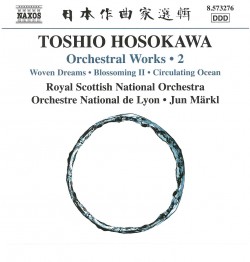 Hosokawa – Orchestral Works 2
Hosokawa – Orchestral Works 2
Royal Scottish National Orchestra; Orchestre National de Lyon; Jun Märkl
Naxos 8.573276
Toshio Hosokawa is in some way a visual artist disguised as a composer. The three pieces on this collection of orchestral music bear a striking similarity of form; they remind me of St. Exupéry’s descriptions of his childish drawings of boa constrictors who swallowed elephants. The author never succeeded in conveying how fearsome these images were to him; Hosokawa’s music, on the other hand, delivers moments of awe and terror, bordered by serenity and contemplation.
Each work opens with a sustained unison B flat, shimmering and pulsing; eventually each arrives at a final unison elsewhere. Hosokawa rejects artifice and architecture, preferring the organic. He depicts development, origins, growth. The first piece, Woven Dreams, traces an imaginary passage from the womb. Blossoming II and Circulating Ocean are reflections on the natural world. In the liner notes he describes the signature unison openings as fluid, amniotic or aquatic. One hears birdsong and water droplets, earthquakes and storms.
Though Hosokawa’s forms have curved edges, his orchestral effects often jar. He discovers new dissonances through note bends and microtonal juxtaposition. Deep booming percussion nearly overwhelms. At times his orchestration reminds me of Schnittke, at others of Mahler. He will use the orchestra as a huge macabre organ and then exploit individual instruments for passagework.
Unlike his senior compatriot, Toru Takemitsu, Hosokawa chose to embrace rather than distance himself from his own culture. He often uses canonic melodic entries, often cascades in the treble winds. He refers to this technique as Oibuki, featured in a style of Japanese court music called Gagaku. Where Takemitsu was repelled by the militarism he witnessed as boy, Hosokawa worries his culture is too ready to adopt external models rather than grow from its own roots.
Two different orchestras supply the music, under the able direction of Jun Märkl, whose parents bridge the east-west musical divide, a German violinist for a father, his mother a Japanese pianist.



